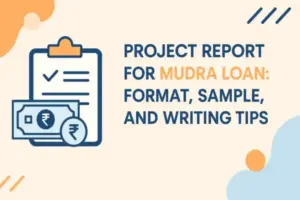Facing Mudra loan rejection can be disheartening, but understanding why it happened and how to address it can turn things around. This article will explore common reasons for Mudra loan rejection, immediate actions to take after rejection, and ways to improve your chances when reapplying. Let’s get started on the path to securing your business financing.
Key Takeaways
- Common reasons for Mudra loan rejection include incomplete documentation, low credit scores, lack of proof of business operations, and income mismatch.
- After rejection, obtain a written reason from the bank, address the identified issues, and consider appealing the decision or reapplying with improved documentation.
- To enhance future applications, maintain good banking habits, prepare a well-drafted business plan, and ensure all documents are accurate and up-to-date.
Introduction
For small business owners and entrepreneurs, securing a Mudra Loan can be a game-changer. This government-backed scheme under the Pradhan Mantri Mudra Yojana (PMMY) is designed to provide financial support to micro enterprises, helping them expand and thrive. However, with the growing demand for Mudra loans, rejection rates have also been on the rise, so applicants should understand the process and prepare thoroughly. Additionally, microfinance institutions play a crucial role in supporting small businesses initiatives. Personal loans can also be considered by those looking for additional funding options.
The frustration of having a loan application rejected can be overwhelming. But a rejection doesn’t mean you’re permanently ineligible for financing. Often, it’s a matter of understanding what went wrong and taking steps to address those issues.
This blog post aims to guide you through the most common reasons for Mudra loan rejection, what to do immediately after facing rejection, and how to successfully appeal and reapply. Following these steps can improve your chances of obtaining the financial support needed to take your business to the next level.
Common Reasons for Mudra Loan Rejection

- Incomplete or Incorrect Documentation: Submission of incomplete or incorrect documents such as identity proof, business registration, bank statements, or financial statements can lead to immediate rejection.
- Low Credit Score: A low or non-existent credit score indicates financial instability and raises concerns for lenders about the borrower’s repayment capacity.
- Lack of Business Proof: Failure to provide adequate proof of ongoing business operations or a clear and detailed business plan can result in rejection.
- Income Mismatch: If the applicant’s income does not align with the repayment capacity required for the loan amount, lenders may reject the application after assessing the debt-to-income ratio.
- Missing Eligibility Criteria: Not meeting the eligibility criteria set by the lender or the Mudra scheme, such as age limits, business type, or registration status, can cause rejection.
- Existing Outstanding Debts: Having high outstanding debts or existing loans can signal financial strain, making lenders hesitant to approve additional loans.
- Lack of Collateral When Required: Although Mudra loans are generally collateral-free, some lenders may require security for higher loan amounts, and lack of collateral can cause rejection.
- Poor Business Financials: Weak financial statements or inconsistent cash flow in the business can reduce the chances of loan approval.
- Incorrect or Missing Tax Returns: Not providing up-to-date or accurate tax returns can raise red flags during the loan evaluation process.
- Common Mistakes in Application: Errors such as submitting wrong details, applying to multiple banks simultaneously, or not following application guidelines can lead to rejection.
Having all necessary documents, a clear business plan, and meeting eligibility criteria can significantly improve your chances of loan approval and help avoid these common pitfalls.
What to Do Immediately After Mudra Loan Rejection

Facing a Mudra loan rejection can be disheartening, but panic is unnecessary. Rejection doesn’t mean permanent ineligibility. View it as an opportunity to understand your shortcomings and improve your application.
Obtain Written Reason: First, obtain a written reason for the rejection from the bank. This document will provide insight into what went wrong, whether it was due to incomplete documentation, a low credit score, a cibil score, or other factors. Knowing the specific reason helps address the issue effectively.
Save Application Reference Number: Save the reference number of your loan application and review which documents or eligibility criteria were not met. This information is vital for your next steps, whether you appeal the decision or reapply with improvements.
Review Documentation Carefully: Check your submitted documents thoroughly to identify any missing or incorrect information that may have led to rejection.
Assess Eligibility Criteria: Re-examine the eligibility criteria to ensure you meet all requirements set by the lender and the Mudra scheme.
Plan Your Next Steps: Decide whether to appeal the rejection or reapply after addressing the issues identified. Prepare any additional documentation or improvements needed.
Seek Professional Advice: Consider consulting a financial advisor or a Chartered Accountant to help understand the rejection reasons and guide you in strengthening your application.
Maintain a Positive Outlook: Keep a constructive mindset and use the rejection as a learning opportunity to improve your chances in future applications.
How to Appeal the Rejection – Step-by-Step Process
Knowing why your loan was rejected enables you to address the underlying issues effectively. The appeal process involves several steps, beginning with direct communication with the bank and escalating to higher authorities if needed.
The following steps will guide you through the appeal process:
Step 1: Visit the Same Bank Branch
Begin by visiting the same bank branch where you initially submitted your loan application. This step facilitates direct communication with bank officials who can provide detailed clarification on the reasons for rejection. Bring all relevant documents and information about your loan application to have a productive discussion with the loan officer.
Direct engagement with the branch manager can be beneficial because:
- Knowing the specific reasons for rejection allows you to address those issues.
- A respectful and polite demeanor might encourage the bank manager to offer guidance on improving your application.
- This increases the likelihood of receiving assistance in resubmitting.
Step 2: File a Grievance
If visiting the bank branch doesn’t resolve the issue, the next step is to file a formal grievance:
- Write a detailed and respectful appeal letter to the Branch Manager.
- Clearly document your grievance in the letter.
- Include all relevant documents with your appeal.
- Mention your application reference number in the letter.
Submit your grievance through the bank’s official grievance redressal mechanism and retain a copy for your records.
You can also approach the MUDRA Customer Service Cell in person or through written communication, or use the Centralized Public Grievances Redress and Monitoring System (CPGRAMS) to lodge your complaint online.
Step 3: Escalate to Higher Authorities
If your grievance is not resolved at the branch level, escalate the issue to higher authorities. Contact the Zonal or Regional Manager of the bank and use the bank’s official grievance redressal portal for further assistance.
Approaching the bank’s higher management ensures thorough review of your case. If unresolved, continue to escalate your complaint through official grievance channels.
Step 4: File Complaint with RBI Banking Ombudsman
If your issue is still unresolved after 30 days, you can file a complaint with the RBI Banking Ombudsman. The RBI Ombudsman serves as a mediator for resolving banking complaints that have not been addressed satisfactorily by the bank.
Lodge your complaint online through the RBI’s complaint management system, providing all relevant details and documents to support your case. The Ombudsman will review your complaint and work towards a resolution.
Reapplying for Mudra Loan After Rejection

Improving your application before reapplying for a Mudra loan increases your chances of approval. Here are some steps you can take:
- Improve Your Credit Score: If your credit score was an issue, focus on improving it. Pay off existing debts, avoid late payments, and ensure your credit report is accurate.
- Update KYC and Business Documents: Ensure all your KYC and business documents are correct and up-to-date. This includes identity proof, business registration, and financial statements.
- Prepare a Better Project Report: Create a detailed project report with a clear cash flow projection. This will demonstrate to lenders that you have a solid business plan and the capacity to repay the loan.
- Consider Other Lenders: If one bank rejects your application, consider applying through another bank, NBFC, or a Common Service Centre (CSC). Different lenders have different criteria, and you might have better luck elsewhere.
- Reapply After Improvements: Reapply after 2–3 months with the necessary improvements. This gives you time to address the issues leading to the initial rejection and present a stronger application.
Pro Tips to Avoid Rejection Next Time

Follow these pro tips to improve your chances of loan approval and avoid immediate rejection in the future:
- Attach a Well-Drafted Project Report: A clear and detailed project report is crucial. It should outline your business plan, cash flow projections, and how the loan will be utilized.
- Include All Relevant Documents: Ensure all necessary documents are included with your application. This includes business registration, GST (if applicable), and income proof.
- Avoid Applying at Multiple Banks Simultaneously: Applying for loans at multiple banks at the same time can be seen as a sign of financial desperation. Stick to one lender at a time.
- Maintain Good Banking Habits: Avoid cheque bounces and maintain a good transaction history. This demonstrates financial discipline and increases your credibility with lenders.
- Seek Professional Help: Consider taking help from a Chartered Accountant (CA) or a professional for documentation and financial planning. Their expertise can significantly enhance your application.
Sample Grievance Letter / Appeal Format
Here’s a simple and clear format for writing a grievance letter:
[Your Name] [Your Address] [City, State, ZIP Code] [Email Address] [Phone Number] [Date]
To, The Branch Manager, [Bank Name] [Branch Address] [City, State, ZIP Code]
Subject: Appeal for Reconsideration of Mudra Loan Application
Dear Sir/Madam,
I am writing to formally appeal the rejection of my Mudra loan application (Reference Number: [Application Number]) submitted on [Date]. I have attached all relevant documents, including additional information requested, for your review. I kindly request a re-evaluation of my application and an opportunity to address any issues that led to the initial rejection.
Thank you for your time and consideration.
Sincerely, [Your Name]
The analysis revealed that the data could be divided into four categories, each representing a distinct aspect of the overall findings.
Where to Seek Help?
If you need additional assistance, there are several resources available:
- Bank’s Grievance Redressal Cell: Contact the grievance redressal cell of your bank for help with your loan application issues.
- PMMY Helpline: Call the PMMY helpline at 1800 180 1111 or 1800 11 0001 for support and guidance.
- CSC Centers: Visit Common Service Centres (CSC) in rural areas for help with Mudra loan applications.
- Financial Consultants: Seek advice from financial consultants or Chartered Accountant firms for professional assistance in preparing your loan application.
Conclusion

Rejection of a Mudra loan application is not the end—it’s an opportunity to improve and reapply. Understanding the reasons for rejection and addressing them can significantly enhance your chances of loan approval.
Stay prepared, stay informed, and don’t hesitate to seek professional help from a financial advisor. With the right approach, you can secure the finance support needed to expand your business and achieve your entrepreneurial goals.
Summary
In summary, common reasons for Mudra loan rejection include incomplete documentation, low credit scores, and lack of a clear business plan. Following a rejection, it’s important to obtain a written reason, understand what went wrong, and take steps to address the issues. The appeal process involves visiting the bank branch, filing a grievance, escalating to higher authorities, and, if necessary, filing a complaint with the RBI Banking Ombudsman.
By following the pro tips outlined in this post and seeking help from available resources, you can avoid future rejections and improve your chances of securing a Mudra loan. Rejection is not the end; it’s a chance to refine your approach and achieve your business goals.
Frequently Asked Questions
What should I do immediately after my Mudra loan application is rejected?
Immediately after your Mudra loan application is rejected, obtain a written explanation for the rejection to identify the specific issues, and make sure to keep your loan application reference number for future reference. This will help you address any shortcomings and improve your chances in the future.
How can I appeal a Mudra loan rejection?
To appeal a Mudra loan rejection, begin by visiting the bank branch where you applied to discuss the reasons for the rejection. If the issue remains unresolved, escalate your grievance to higher authorities or file a complaint with the RBI Banking Ombudsman for further assistance.
What are common reasons for Mudra loan rejection?
Mudra loan rejections often stem from incomplete documentation, low credit scores, lack of adequate business proof, and income discrepancies affecting repayment capacity. Ensuring accurate and comprehensive documentation can significantly improve approval chances.
Can I reapply for a Mudra loan after rejection?
Yes, you can reapply for a Mudra loan after rejection by improving your credit score and documentation, as well as refining your project report. It’s recommended to wait 2–3 months before reapplying to enhance your chances of approval.
Where can I seek help with my Mudra loan application?
You can seek help with your Mudra loan application by contacting your bank’s grievance redressal cell, calling the PMMY helpline at 1800 180 1111 or 1800 11 0001, visiting CSC centers, or consulting with financial experts.
- Rejected Mudra Loan – What to Do Next? Appeal Process Explained
- Mudra Loan for Used Vehicle: Benefits, Interest Rates, and Eligibility Criteria
- Is the Mudra Loan Subsidy Real or Fake? Get the Facts Here
- Get Your Mudra Loan Approved: Write a Perfect Project Report with This Guide
- Mudra Loan Without CIBIL Score: How to Qualify and Apply
- Mudra Loan Without PAN Card: Eligibility & Application Process Explained
- Secure Your Future: Mudra Loan for Salaried Person Explained
- Mudra Loan for Senior Citizens or Retired Persons – Eligibility, Benefits & Myths
- Mudra Loan for Disabled Persons: Eligibility, Interest Rates, and Benefits
- Best Tips for Securing a Mudra Loan for SC ST Applicants
- Top Benefits of Mudra Loan for Women Entrepreneurs
- How to Get Mudra Loan for Franchise Business in India
- Mudra Loan for Home Business: How to Apply and Benefits
- Can I Get Mudra Loan Without GST or Udyam Registration?
- Mudra Loan for Amazon Seller, Dropshipping, and Affiliate Marketing – Is It Possible?
- Best Mudra Loan for Housewives – Empowering Women Across India
- Top Reasons for Mudra Loan Rejected and How to Fix Them
- Best Business Idea Under Mudra Loan 5 Lakh for 2025
- Mudra Loan for Used Machine: Eligibility, Interest Rates & Benefits



















